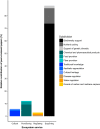Ecosystem services provided by bromeliad plants: A systematic review
- PMID: 31380056
- PMCID: PMC6662323
- DOI: 10.1002/ece3.5296
Ecosystem services provided by bromeliad plants: A systematic review
Abstract
The unprecedented loss of biological diversity has negative impacts on ecosystems and the associated benefits which they provide to humans. Bromeliads have high diversity throughout the Neotropics, but they have been negatively affected by habitat loss and fragmentation, climate change, invasive species, and commercialization for ornamental purpose. These plants provide direct benefits to the human society, and they also form microecosystems in which accumulated water and nutrients support the communities of aquatic and terrestrial species, thus maintaining local diversity. We performed a systematic review of the contribution of bromeliads to ecosystem services across their native geographical distribution. We showed that bromeliads provide a range of ecosystem services such as maintenance of biodiversity, community structure, nutrient cycling, and the provisioning of food and water. Moreover, bromeliads can regulate the spread of diseases, and water and carbon cycling, and they have the potential to become important sources of chemical and pharmaceutical products. The majority of this research was performed in Brazil, but future research from other Neotropical countries with a high diversity of bromeliads would fill the current knowledge gaps and increase the generality of these findings. This systematic review identified that future research should focus on provisioning, regulating, and cultural services that have been currently overlooked. This would enhance our understanding of how bromeliad diversity contributes to human welfare, and the negative consequences that loss of bromeliad plants can have on communities of other species and the healthy functioning of the entire ecosystems.
Keywords: biodiversity; bromeliad plants; climate regulation; disease; ecosystem services; microecosystems; neotropics; pharmaceutical potential; water storage.
Conflict of interest statement
None declared.
Figures



Similar articles
-
Effects of warming on the structure of aquatic communities in tropical bromeliad microecosystems.Ecol Evol. 2023 Feb 22;13(2):e9824. doi: 10.1002/ece3.9824. eCollection 2023 Feb. Ecol Evol. 2023. PMID: 36844665 Free PMC article.
-
Effects of predatory ants within and across ecosystems in bromeliad food webs.J Anim Ecol. 2017 Jul;86(4):790-799. doi: 10.1111/1365-2656.12671. Epub 2017 Apr 27. J Anim Ecol. 2017. PMID: 28342283
-
Rainfall changes affect the algae dominance in tank bromeliad ecosystems.PLoS One. 2017 Apr 19;12(4):e0175436. doi: 10.1371/journal.pone.0175436. eCollection 2017. PLoS One. 2017. PMID: 28422988 Free PMC article.
-
Effects of air pollution on ecosystems and biological diversity in the eastern United States.Ann N Y Acad Sci. 2009 Apr;1162:99-135. doi: 10.1111/j.1749-6632.2009.04153.x. Ann N Y Acad Sci. 2009. PMID: 19432647 Review.
-
Diverse effects of invasive ecosystem engineers on marine biodiversity and ecosystem functions: A global review and meta-analysis.Glob Chang Biol. 2018 Mar;24(3):906-924. doi: 10.1111/gcb.14007. Epub 2018 Jan 4. Glob Chang Biol. 2018. PMID: 29211336 Review.
Cited by
-
An ecological perspective on water shedding from leaves.J Exp Bot. 2022 Feb 24;73(4):1176-1189. doi: 10.1093/jxb/erab479. J Exp Bot. 2022. PMID: 34727175 Free PMC article.
-
New insights into the role of the root system of epiphytic bromeliads: comparison of root and leaf trichome functions in acquisition of water and nutrients.Ann Bot. 2024 Nov 13;134(5):711-724. doi: 10.1093/aob/mcae109. Ann Bot. 2024. PMID: 39021206 Review.
-
Plant growth-promoting traits of yeasts isolated from the tank bromeliad Vriesea minarum L.B. Smith and the effectiveness of Carlosrosaea vrieseae for promoting bromeliad growth.Braz J Microbiol. 2021 Sep;52(3):1417-1429. doi: 10.1007/s42770-021-00496-1. Epub 2021 May 6. Braz J Microbiol. 2021. PMID: 33956333 Free PMC article.
-
Effects of warming on the structure of aquatic communities in tropical bromeliad microecosystems.Ecol Evol. 2023 Feb 22;13(2):e9824. doi: 10.1002/ece3.9824. eCollection 2023 Feb. Ecol Evol. 2023. PMID: 36844665 Free PMC article.
-
Traditional uses of wild and tended plants in maintaining ecosystem services in agricultural landscapes of the Eastern Cape Province in South Africa.J Ethnobiol Ethnomed. 2022 Mar 15;18(1):17. doi: 10.1186/s13002-022-00512-0. J Ethnobiol Ethnomed. 2022. PMID: 35292046 Free PMC article.
References
-
- Acebey, A. , Krömer, T. , Maass, B. L. , & Kessler, M. (2010). Ecoregional distribution of potentially useful species of Araceae and Bromeliaceae as non‐timber forest products in Bolivia. Biodiversity and Conservation, 19(9), 2553–2564. 10.1007/s10531-010-9859-0 - DOI
-
- Albertasse, P. D. , Thomaz, L. D. , & Andrade, M. A. (2010). Medicinal plants and their uses in Barra do Jucu community, Vila Velha Municipality, Espírito Santo State, Brazil. Revista Brasileira De Plantas Medicinais, 12(3), 250–260.
-
- de Almeida, C. D. F. C. , Rangel, B. , Ramos, M. A. , Silva, R. R. V. , de Melo, J. G. , Medeiros, M. F. T. , … de Albuquerque, U. P. (2011). Intracultural variation in the knowledge of medicinal plants in an urban‐rural community in the Atlantic Forest from Northeastern Brazil. Evidence‐Based Complementary and Alternative Medicine, 2012, 679373. - PMC - PubMed
-
- Araújo, F. V. , Medeiros, R. J. , Mendonça‐Hagler, L. C. , & Hagler, A. N. (1998). A preliminary note on yeast communities of bromeliad‐tank waters of Rio de Janeiro, Brazil. Revista De Microbiologia, 29(2), 118–121.
Publication types
Associated data
LinkOut - more resources
Full Text Sources
Other Literature Sources

